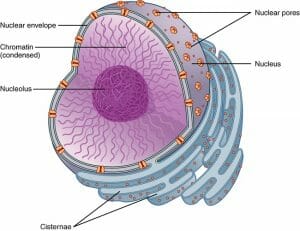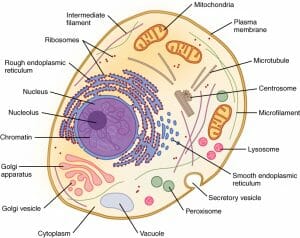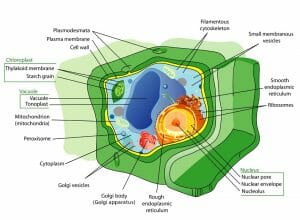Cell Nucleus Definition
The cell nucleus is a large organelle in eukaryotic organisms which protects the majority of the DNA within each cell. The nucleus also produces the necessary precursors for protein synthesis. The DNA housed within the cell nucleus contains the information necessary for the creation of the majority of the proteins needed to keep a cell functional. While some DNA is stored in other organelles, such as mitochondria, the majority of an organism’s DNA is located in the cell nucleus. The DNA housed in the cell nucleus is extremely valuable, and as such the cell nucleus has a variety of important structures to help maintain, process, and protect the DNA.
Cell Nucleus Structure
A cell nucleus is surrounded by a double membrane, known as the nuclear envelope. This membrane covers and protects the DNA from physical and chemical damage. In doing so, the membrane creates a separate environment to process the DNA in. The outer membrane is in contact with the cytoplasm, and connects in some places to the endoplasmic reticulum. The inner membrane connects to the nuclear lamina. This nuclear framework inside the cell nucleus helps it maintain its shape. There is also evidence that this scaffolding of proteins helps form a matrix to transport and distribute products within and out of the nucleus. Nuclear pores create passages through the nuclear membrane, and allow products of the cell nucleus to enter the cytoplasm or endoplasmic reticulum. The pores also allow some specific macromolecules and chemicals from the cytoplasm to pass back into the cell nucleus. These macromolecules are needed to synthesize DNA and RNA, and are needed for the creation of new proteins and macromolecules within the cell nucleus. In a stained nucleus, a dark spot can be seen. This spot is the nucleolus. Within the nucleolus, the several different parts of ribosomes are produced and exported. These structures can be seen in the following image.
While the cell nuclei of plants and animals differ in subtle ways, their main purpose and general activities remain the same. The cell nucleus is responsible for producing two main products to support the efforts of each cell. The first, messenger RNA, or mRNA, is the product of transposing a gene coding for a specific protein from the DNA structure to the RNA structure. This shorter mRNA strand can exit the nucleus and enter the cytoplasm. When a ribosome picks up this mRNA, it will translate this mRNA into the language of proteins and create a long strand of amino acids. This strand will then be folded into a functional protein, which may serve one of a thousand different roles. Examples of the differences between plant and animal cell nuclei can be seen below.
Function of Cell Nucleus
Animal Cell Nucleus
This generic animal cell has all the components that every animal cell has. The cell nucleus can be seen on the left side of the cell. It is the large purple circle. Remember that this is a cross-section view, and in reality the nucleus would be more of a sphere. In animal cells it usually takes a spherical shape if there is enough room within the cell. The nucleus is surrounded by the endoplasmic reticulum, which is covered in spots by ribosomes. When the animal cell divides, the nucleus breaks up, and the nuclear envelope falls apart. The nuclear envelope is then reassembled around each new nucleus after the chromosomes have been divided.
Plant Cell Nucleus
Above is a generic plant cell. Notice how it has a rigid shape, due to the presence of a cell wall. Further, a large central vacuole occupies the majority of the cell, pushing all the other constituents to the sides of the cell. The nucleus here is orange, shown with a chunk taken out to expose the interior. Like animal cell nuclei, this cell nucleus will retain a spherical shape if there is enough room. Oftentimes in plant cells, the central vacuole expands with water to apply pressure to the cell walls. This pressure forces the nucleus into a more flattened, oblong shape. As with animal cell nuclei, this cell nucleus will break down during cell division. Unlike animal cells, plant cells must build new cell walls between dividing cells. The two new nuclei must be moved away from the metaphase plate, or the nuclei may become damaged by the formation of the cell wall.
Other Examples of Cell Nuclei
Besides these two simple examples of cell nuclei, there are countless variations to these two general schemes in nature. Some cells merge together, creating large cells with multiple cell nuclei in each cell. Many organism have cells with more than one nucleus, including humans. Human muscle cells are multi-nucleated. Other organisms, like some fungi, exist with most or all of their cells being multi-nucleated. In some organisms, the process of cell division does not include the breakdown of the nuclear envelope. Instead, microtubules extend through the cell nucleus and directly manipulate the chromosomes and work to divide the nucleus. Evolutionarily, it is assumed that early organisms that developed nuclei had clear advantages over those without. Over the course of millennia, different strategies for managing and maintaining the cell nucleus have evolved. While the nucleus may seem like a more advanced form of life, don’t forget that prokaryotes, like bacteria and other single-celled life forms, are still some of the most abundant on the planet. That being said, the cell nucleus has evolved as a highly successful strategy in multi-cellular forms of life.
Quiz
1. Why is it helpful for a cell to protect its DNA within a cell nucleus?
A. To shield from chemical changes
B. To protect from physical damage
C. Both of the above
2. As mentioned early in this article, mitochondria also contain DNA. Are mitochondria a different form of cell nucleus?
A. Yes, any organelle with DNA is a nucleus.
B. No, their DNA doesn’t produce anything
C. No, because mitochondrial DNA isn’t protected the same way
3. When looking at stained nuclei under a microscope, you notice that some appear uniformly colored, while other appear almost empty, with most of the color clumped together in the middle. What is happening?
A. The cells are dividing
B. Your stain is not working properly
C. The cells are from different species
References
- Nelson, D. L., & Cox, M. M. (2008). Principles of Biochemistry. New York: W.H. Freeman and Company.



